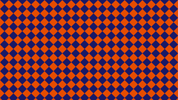fn_diamondPattern 
Function call: fn_diamondPattern (uv, color1, color2, number, edgeSharpness);
Example with values: fn_diamondPattern (uv, 0.0.xxx, 1.0.xxx, 20.0.xx, 1000.0);
(Result see image)
Purpose:
Generating a selectable number of diamonds with changing color or brightness or other RGB source.
This can be a color, or a texture from a sampler.
Adjustable edge softness of the squares.
More details see the parameter descriptions.
Required global definitions and declarations:
(add outside and above all shaders and functions):
//-----------------------------------------------------------------------------------------//
// Definitions and declarations
//-----------------------------------------------------------------------------------------//
float _OutputAspectRatio;
#define PI 3.141592654
Code (Example as a float3 RGB function without alpha):
float3 fn_diamondPattern (float2 uv, float3 color1, float3 color2, float2 number, float edgeSharpness)
{
float2 mix = float2 (uv.x + (uv.y / _OutputAspectRatio) , 0.0);
mix.y = uv.x - (uv.y / _OutputAspectRatio);
mix = sin (mix * PI * number ) * edgeSharpness / number;
mix = clamp( mix, -0.5, 0.5) + 0.5;
return lerp (color1, color2, lerp( mix.y , 1.0 - mix.y, mix.x));
}
When making code changes, note that color1 and color2 must have the same float type.
Code description at the bottom of this page.
Parameter Description
uv:
Enter the name of the used texture coordinate variable.
Type:float2
color1:
Color of the diamonds.
Type:float3(RGB)- This can be a color, or a texture from a sampler.
color2:
Color of the other diamonds.
Type:float3(RGB)- This can be a color, or a texture from a sampler.
number:
Number of squares in a horizontal line.
Type:float2
To create equal edge lengths (squares), the x and y parameters must be identical.
Value range: > +1 or < -1
Illegal value is 0 (leads to division by 0)
edgeSharpness:
Edge sharpness of the squares
Type:float
Value range: > +1 or < -1
Values around 1000 and above result in relatively sharp edges for HD formats.
At 200 and below, the edge smoothness is clearly visible.
Return value:
- The value of the parameter
color1orcolor2(in the change of squares) - Type: float3 (same type as
color1andcolor2) - Value range: 0.0 to 1.0
Code description
The code at the top of this page is compressed.
For a better understanding, the uncompressed code is described here:
float3 fn_diamondPattern (float2 uv, float3 color1, float3 color2, float2 number, float edgeSharpness)
{
float x = uv.x + (uv.y / _OutputAspectRatio);
x = sin (x * PI * number.x );
x *= edgeSharpness / number.x;
x = clamp( x, -0.5, 0.5);
x += 0.5 ;
float y = uv.x - (uv.y / _OutputAspectRatio);
y = sin (y * PI * number.y );
y *= edgeSharpness / number.y;
y = clamp( y, -0.5, 0.5);
y+= 0.5 ;
float mix = lerp( y , 1.0 - y, x);
return lerp (color1, color2, mix);
}
Code description:
Diagonal 45° lines ( Details and code description )
float x = uv.x + (uv.y / _OutputAspectRatio);
x = sin (x * PI * number.x );
x *= edgeSharpness / number.x;
x = clamp( x, -0.5, 0.5);
x += 0.5 ;
Diagonal 45° lines, turned 90° to previous code ( Details and code description )
float y = uv.x - (uv.y / _OutputAspectRatio);
y = sin (y * PI * number.y );
y *= edgeSharpness / number.y;
y = clamp( y, -0.5, 0.5);
y+= 0.5 ;
float mix = lerp( y , 1.0 - y, x); Pattern generation from the Diagonal 45° lines.
return lerp (color1, color2, mix); Assignment to the set colors.
Screenshot
